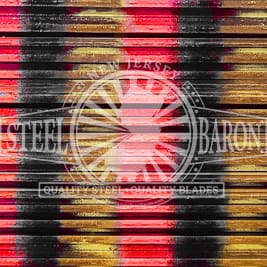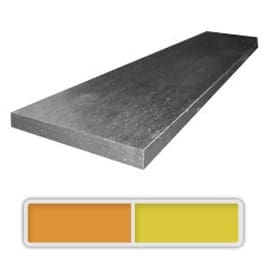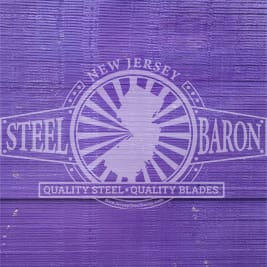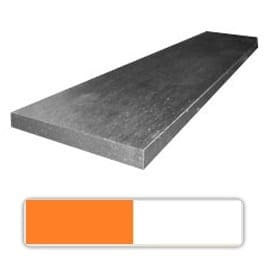Description
CPM S90V is a unique tool steel made by the Crucible, a martensitic stainless steel with a high volume of vanadium carbides means a blade with exceptionally good wear resistance and wicked sharp edges.
S90V offers substantial improvements in wear resistance over other high chromium tool steels, such as D2, and corrosion resistance on par or above most 440C type steels.
These attributes are the byproduct of its high volume of vanadium carbides to chromium carbides, where one adds wear resistance, the chromium in the matrix provides good corrosion resistance.
A favorite among folder and kitchen knife makers, S90-V is known for taking an exceptional satin finish to match its excellent edge retention properties.
When you need something more than a typical Crucible CPM but not as tough to work as CPM M4, give S90-V some thought, we are sure you will be happy you did.
Only logged in customers who have purchased this product may leave a review.
Heat Lot Certifications
Listed below are our current LIVE and the most recently CLOSED material lot certifications per thickness:
| Previous | Current |
|---|
| CPM S90-V.070 (1/16”) | N/A | N/A |
|---|
| CPM S90-V .094 (3/32”) | NP68958 | NP69668 |
|---|
| CPM S90-V .125 (1/8”) | N/A | NP69337 |
|---|
| CPM S90-V .156 (5/32”) | N/A | NP69472 |
|---|
| CPM S90-V .187 (3/16”) | N/A | NP69472 |
|---|
| CPM S90-V .250 (1/4”) | N/A | N/A |
|---|
CPM S90V Heat Treat
You can download our CPM S90V Heat Treat PDF. It contains all of the information mentioned below.
Important – Before Treating
- Knives should be cleaned by washing with soapy water and then either placed into foil pouch or coated with high temperature anti-scale/decarburization compound prior to heat treat if not using Oxygen free heat treat equipment.
- Skipping stages such as pre-heating and equalizing or cryo will result in lower hardness, higher amounts of Retained Austenite (RA), impaired stain resistance or other issues. Ramp AFAP (as fast as possible) between preheating and austenizing temps.
- Clamping flat after quench during cryo or tempering recommended to avoid thermal shock induced warp.
- Figures represent quenching under positive pressure with aluminum plates and compressed air to at or below 125°F / 50°C–alternative quenching methods may present lower hardness, high RA, or other issues.
| Pre-Heat/Equalizing |
Austenizing Temperature |
Expected RC
(as quenched prior to cryo) |
1,450°F / 787°C
Hold 10 Minutes |
2,100°F / 1150°C
Soak 20 Minutes |
60RC (61 after Cryo) |
Cyrogenic Treatment
- A cryogenic treatment is recommended to convert retained austenite, and can either be done before or after the first temper cycle.
- Liquid nitrogen is recommended, dry ice/kerosene may be substituted–Current available Crucible spec sheet does not include specific sub-zero range.
- Submerge in sub-zero treatment 6-8 hours depending on thickness and number of blades.
- A cryogenic treatment can be done immediately done after quench, but it is recommended blades be clamped flat to avoid thermal shock induced warp–cryo treatment should always be followed by a tempering cycle.
Tempering
- Once blade is quenched and near ambient temperature, blades should be tempered accordingly, the times suggested are to ensure even, consistent temperature.
- Figures supplied are as representative of industrial standards.
- If using a small toaster oven or household kitchen oven for tempering, using a blade holding rack made from kiln furniture, a roasting tray lined with fine sand, or similar large object will help retain thermal mass to reduce wide swinging temperatures as the device fluctuates trying to maintain temperature.
- Note: Final hardness values vary based on initial as-quenched hardness and percentage of conversion to Martensite. Only reliable testing methods, e.g. calibrated Rockwell hardness tester, can provide actual hardness values–hardness calibrated files and chisels are relative testing methods and inaccurate for true hardness value reading.
- Temper twice for 2hrs.
- Manufacturers warn against tempering at 800°F / 425°C and above as sensitization will result in reduction of toughness and corrosion resistance.
- The included Heat Treat Schedule on this page is formulated based upon Industry standards and data from ASM International, Crucible and other foundry spec sheets, and Kevin Cashen (independent researcher, ferroalloy metallurgist, and bladesmith of Matherton Forge).
| Temperature |
Hardness (2 hour x2 guideline) |
| 400°F / 204°C |
60-61RC |
Heat Treating Disclaimer
- Suggested heat treatment are based on the recommended specifications for use in ovens, high temp salts, and similarly, properly calibrated equipment; and in line with proper industrial standards for quenching. Deviation from industry standards for schedules, equipment, quenching mediums; and hardness testing equipment may result in varied results. The supplied information on this page is on a generalized scale with the above mentioned standards and methods, which is why soak times and similar aspects may vary in time length to include a margin for the available heat treating equipment and steel cross section.
- If you are unsure if you have the necessary means to heat treat on-site, we recommend professional heat treating services provided by Peters Heat Treat or Bos Heat treating; or industry specific services by knife material dealers such as TruGrit or Texas Knifemaker’s Supply–check with suppliers to see if they offer HT services and ensure they follow industry standards.
- NJSB LLC is not liable or responsible if proper industry heat treating protocols are not applied; particularly and especially if sending to an independent heat treat provider if they do not follow the intended heat treat schedule or standards for that particular steel; or damage they cause while in their possession.








Reviews
There are no reviews yet.